Saturday 22nd June 2024
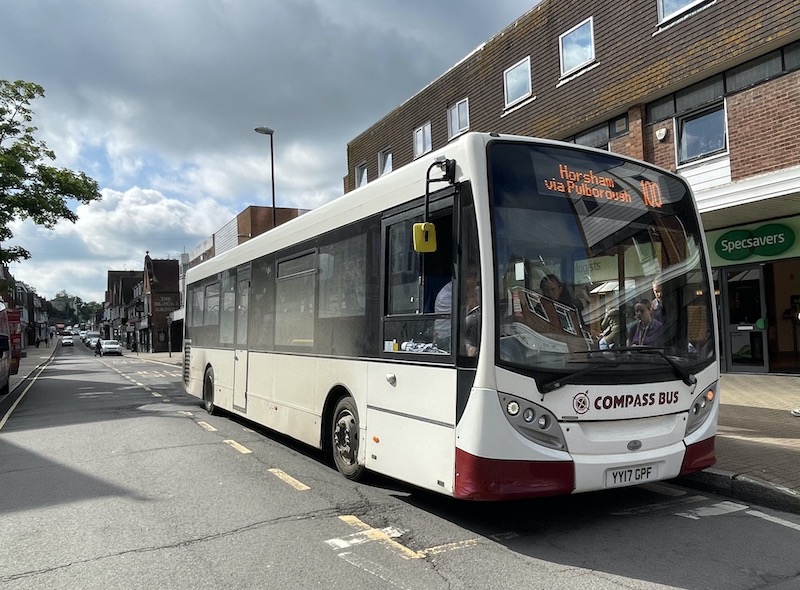
We’re at the halfway stage on this fortnightly odyssey of all Britain’s 26 bus routes numbered 100 so I thought I’d celebrate by taking a ride on my local route 100 in West Sussex.
It’s a fascinating route connecting many small and mid sized towns and villages as it criss-crosses the county from Burgess Hill across to Pulborough and then north to Horsham.

It’s a commercially operated route running every hour on Mondays to Saturdays by the well regarded Compass Bus connecting its terminal points with Hickstead, Sayers Common, Henfield, Upper Beeding, Bramber, Steyning, Washington, Storrington and Pulborough then continuing via Billingshurst, Slinfold and Broadbridge Heath to Horsham.
There’s nothing quite like it, and wasn’t in years gone by, when the grand Southdown bus company ruled the bus roads of Sussex. That company ran well established bus routes between Pulborough, Billingshurst and Horsham as well as between Pulborough, Storrington and Washington (as the latter is still served today by Stagecoach’s route 1 from Midhurst to Worthing) but links between Steyning, Henfield and Burgess Hill are new since Compass Bus took the initiative of operating the route and effectively linked two routes together making for a lengthy two hours and 23 minute journey making it Britain’s longest route 100 by a significant margin.
It takes five buses to run the route with Compass Bus using modern Enviro200s from its fleet.
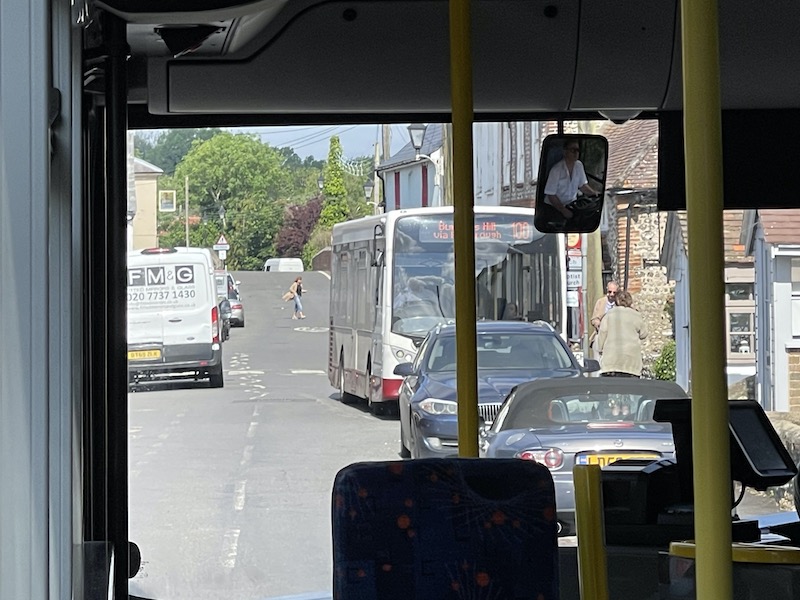
Individual journeys made by passengers on the route are very diverse, as befits the nature of the service as a multi-faceted route. No-one other than Route 100 Bloggers would travel end to end as there are much quicker ways to travel from Horsham to Burgess Hill, going via Patcham, to the north of Brighton for example, or if you time it right on the right day of the week, via Haywards Heath.
When I travelled on the route on a lovely sunny day at the end of last month, it was evident the east-west section of route between Burgess Hill and Pulborough is unsurprisingly weaker than the north-south section between Pulborough and Horsham. This reflects the fact Horsham is a bigger draw than Burgess Hill and communities at that end of the route have a stronger affinity with it than those closer to Burgess Hill.
However, places like Henfield, Steyning and Storrington are well worth stopping off at to explore the traditional “high streets’ they offer as small towns. Similarly with Billingshurst.

I caught the 09:11 departure from Burgess Hill on a Thursday morning and even though we were pre the 09:30 concessionary pass validity, six passengers boarded.

Interestingly one travelled all the way to Storrington (a 70 minute journey) but the other five alighted fairly locally at Burgess Hill’s Tesco, Hickstead, Sayers Common and two in Henfield.
The route involves a short double run in Henfield to serve residential properties to the north of the town before turning round to head back south through the High Street again towards Small Dole, Upper Beeding, Bramber and Steyning. We picked two up in Henfield, one in Small Dole and five in Upper Beeding with six alighting in Steyning and two of the five Upper Beeding boarders making only a short hop to Bramber.
After Steyning we were back down to just the one (Burgess Hill to Storrington) passenger on board but in Storrington three passengers boarded making a short local journey and one went to Pulborough.
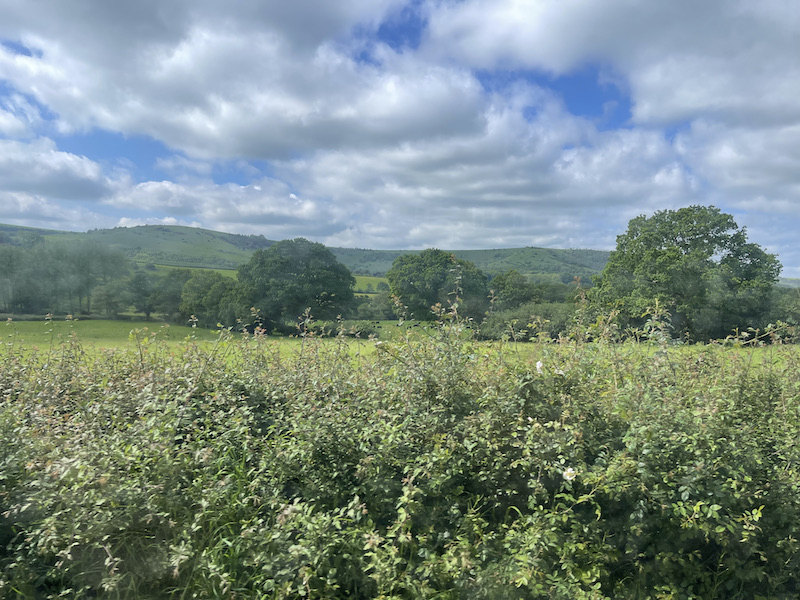
After an 82 minute journey through some lovely Sussex countryside and some great views of the South Downs we pulled into Pulborough railway station where a three point turn manoeuvre is carried out in front of the station building and the bus takes a five minute pause at a similar time to a Burgess Hill bound bus doing the same.
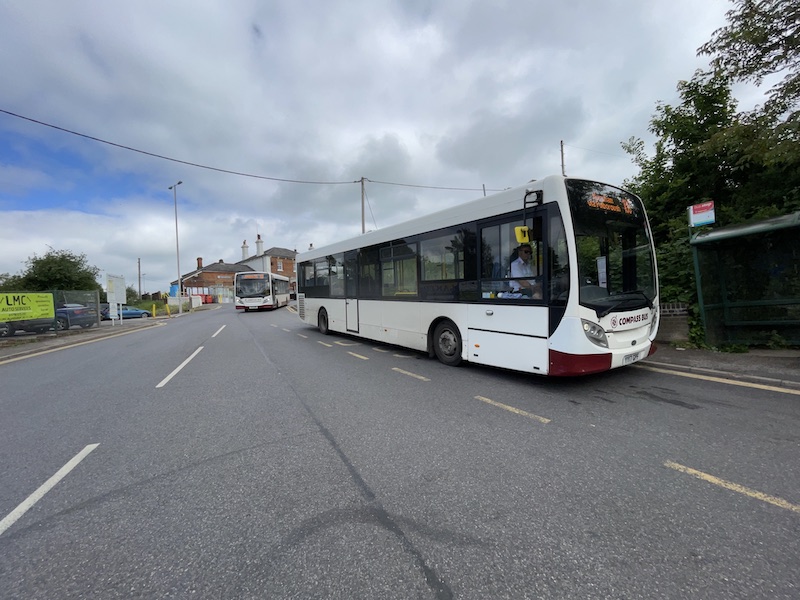
18 passengers had travelled on Part One of the route and I had a feeling Part Two would get busier.
We left Pulborough at 10:38 and once we had retraced our route back to serve the Spinney North residential area we’d picked up four passengers, one of whom travelled to Billingshurst and the other three to Horsham. Five more joined us as we continued on the A29 through Adversane (two to Billingshurst and three to Horsham) and then Billingshurst itself, where we stopped four times as we threaded our way around the town and the High Street, giving us 21 passengers, one of whom travelled to Slinfold and the rest to Horsham.
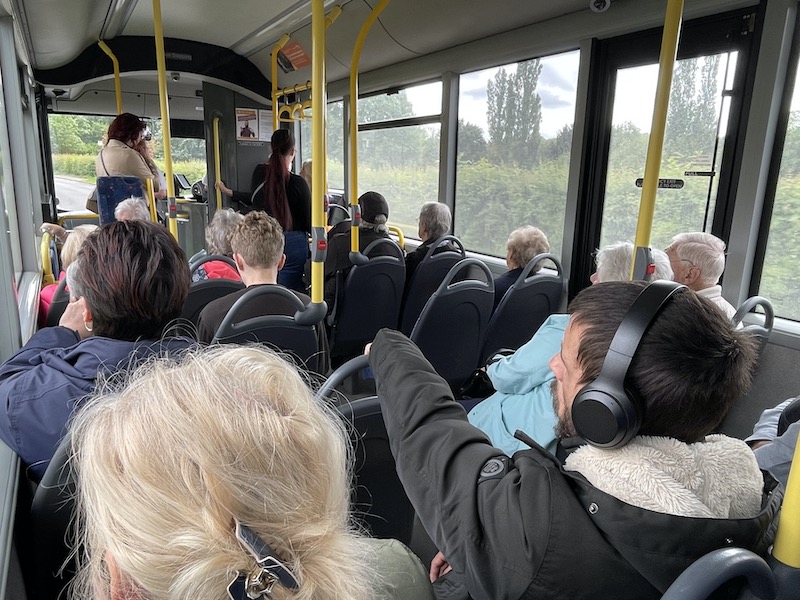
One more joined us in Slinfold and another two in Broadbridge Heath and two in Horsham itself when we reached our maximum of 31 on board including a wheelchair, a buggy and a ‘walker on wheels’ making for a busy bus as we pulled into Horsham bus station on time at 11:33.
The route involves a circuit of the town in Horsham and after a five minute pause in the bus station when 21 alighted and nine joined for the journey back to Pulborough and Burgess Hill, we headed over to the Carfax in the centre of this delightful market town and pleasant shopping area – including cobbled stones (making it the second route 100 to offer such an experience)…
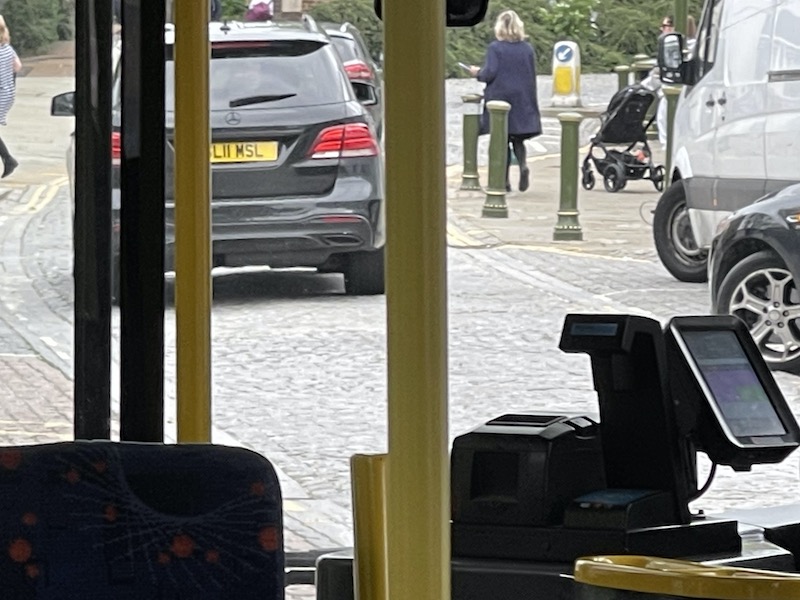
… and where seven of our 31 alighted and we picked up three more. The next stop is Horsham railway station where the final three of the 31 alighted, as did I, letting the bus head on via Horsham Hospital and then back to retrace its route towards Pulborough.

That second half of the route carried 35 passengers making for a very creditable 53 for the whole journey.
And a lovely journey too. A complete mixture of passengers from young, students, middle age, to older.
There was one hairy moment when we met a Burgess Hill bound bus running late on the narrow section of route through the centre of Slinfold. But that was sorted by that bus reversing a short distance to a wider stretch of road.
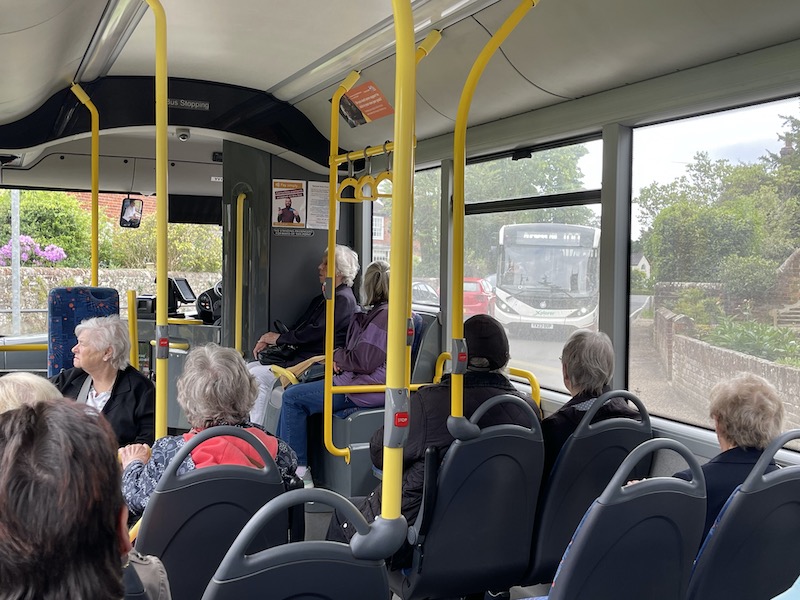
If you want to see West Sussex and have two and a half hours to spare, why not give this route 100 a ride?
Roger French
Have you read the twelve ‘Every route 100’ blogs featured so far? Here’s 1 of 26 (Stevenage-Hitchin) 2 of 26 (Crawley-Redhill), 3 of 26 (Lincoln-Scunthorpe), 4 of 26 (Glasgow-Riverside Museum), 5 of 26 (Campbeltown local), 6 of 26 (Guildford’s Onslow Park & Ride), 7 of 26 (Warrington-Manchester), 8 of 26 Chatham-St Mary’s Island, 9 of 26 St Paul’s-Wapping, 10 of 26 Syston-Melton Mowbray, 11 of 26 Wellington-Telford Sutton Hill, 12 of 26 Hanley-Stone.
Blogging timetable: 06:00 TThS and occasional Summer Su extras including tomorrow.
Comments on today’s blog are welcome but please keep them relevant to the blog topic, avoid personal insults and add your name (or an identifier). Thank you.

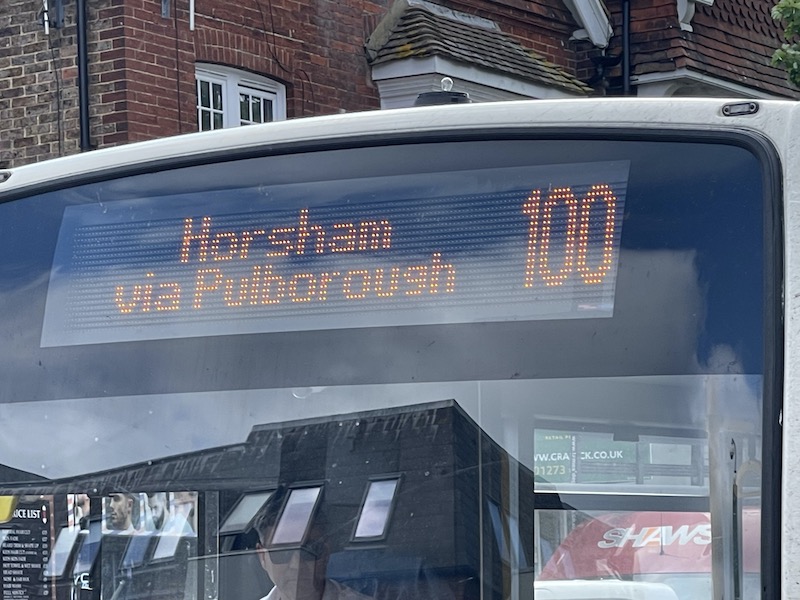
It’s a delightful route and great for walkers: it also stops outside Wiggonholt, the RSPB reserve.
Has the east-bound stop at Hickstead Services been replaced? This was removed in the A2300 dualling and no provision made for a stop, typical of how highway engineers have no regard for public transport. It was said that passengers could walk from the next stop 2km further on! A stop could be provided on the A23 north-bound exit slip instead.
LikeLike
Wonder how long it will be until GoAhead puts in an offer for Compass, it would be very consistent with their current strategy of bolting on independents to their existing operations.
LikeLike
I am not sure this is fully commercial, there must be some public money somewhere, because, as you have highlighted, the section between Pulborough and Burgess Hill is very light on customers. As a Steyning resident, I can say that the number of people using the bus on the day you travelled is exceptional. I have travelled late morning from Burgess Hill and been the only passenger apart from Burgess Hill local riders.
For my money, the route suffers from two issues. Firstly, poor connections to/from other routes, which could increase patronage. For example, connections in Steyning with Brighton & Hove route 2 from and to Shoreham/Brighton are very poor. Typically, the northbound 100 goes through Steyning just in front of the 2 from Brighton, thus preventing any custom there might be eg from Shoreham, etc to Pulborough RSPB. Also, for much of the day, the route fails to offer northbound connections at Washington with Metrobus 23 to Horsham, so travel by bus from Steyning to Horsham is quite difficult – short of staying with the 100 or catching a train at Pulborough.
Second, there are simply too many wanderings, some of which could be got rid of with a bit of thought. For example, running between Albourne and Henfield via High Cross instead of Woodmancote would avoid the double run up Henfield High Street, typically busy and with indiscriminate car/HGV parking. Woodmancote is well served by Stagecoach 17. The time-consuming deviation via Needles Estate in Horsham is well tiresome for people travelling any distance, at any rate on a regular basis.
LikeLike
I was thinking the same. 53 passengers on a journey taking nearly 2.5 hours doesn’t strike me as being that brilliant. What’s the cost of running a commercial operation these days? £30 an hour? Sounds marginal to me unless the peak-hour service is significantly better patronised.
Dan Tancock
LikeLike
Many thanks for this: I’ve been familiar with the route 100 right from its inception back in the late 1990s under John Prescott’s bus-funding scheme, which I’m glad to say West Sussex council took up, and persisted with – in fact I was not aware that this 100 is actually commercially operated now. As you say, it goes through some lovely places, some of which are not served by rail (Henfield, Steyning, Storrington. The timings are not particularly good as regards rail connections at Pulborough station, and the Stagecoach route 1 is only good in one direction – but then, as a mere passenger, I’m used to the sad fact that bus and train people don’t talk to each other about timetabling.
I am glad to see that this route 100 is doing well now. When it started, I think one of the main reasons was for students at Brinsbury college near Adversane, who I saw catch the bus quite often. The route also serves a number of tourist attractions – Bramber castle (see the ‘A Yank in Sussex’ youtube video), Parham House & Garden, Chanctonbury Ring; at Buncton – a short walk from the bus stop – there is one of West Sussex’s delightful tiny churches, and another at Hardham 20 minutes south of Pulborough).
LikeLiked by 1 person
hi roger rob rudwick here, if you’re ever in Worthing areas or Lancing, Shoreham, Southwick please let me know and we can have a bus journey together
LikeLike
As partially mentioned by Rick, this route commenced in 1998, just before I started working for the WSCC public transport team, and I remember one of my first jobs was to take leaflets to publicise the route and to check out some new stop locations as it was a brand new route (at the time it was shorter – Pulborough to Henfield – with the Horsham and Burgess Hill sections added on much later, the Horsham section replacing a variety of routes operating through Billingshurst and focussing on a single corridor, leaving some of the villages west of Horsham less well served). As far as I recall the initial route was initiated by WSCC not Compass Bus but I may be wrong, and I’m not surprised that excellent operator has kept it going and made a good job of it (much like its route 99 Chichester – Petworth which shows everyone really how to run a flexible bus route!). It’s a pity that Rail and bus connections aren’t better (but that it would be near-impossible to get them all to work on an hourly frequency) and that the service ceases so early in the evening. Otherwise it seems to work, doesn’t it!
Stephen H
LikeLike
We managed Steyning to Horsham last Wednesday afternoon by taking the 100 to Henfield and then the Stagecoach 17 back home. The connection was better when the 17 ran every half an hour but tea and cake at the cafe next to Henfield’s impressive bus shelter (like the one at the westbound stop in Steyning) filled in the gap nicely.
Horsham to Steyning via Henfield doesn’t work well if both buses are on time.
LikeLike
Preston bus Service 100 could disappear in September.
https://www.prestonbus.co.uk/news/routes-6-8-19-23-31-35-100-proposed-timetable-and-route-changes/
LikeLike
The livery of Compass Bus seems quite boring , but how you can make such a design of vehicle look more attractive I dont know. Having said that the route seems to do what it says on the tin, connecting communities in the way you would expect “rural” bus services to do at a cost that seems to be covered by the revenue. As ever the question of is a frequent through service conecting to little feeder services in towns and local villages better than one longer service trying to be all things (other than fast) to all people is one of those transport professionals questions. Sometimes a longer route /time allows you time to sleep/browse websites or read newspaper/book or even do your knitting rather than just sitting watching the scenery.
JBC Prestatyn
LikeLike
Compass Bus did unveil a new livery sometime around the coronation – a very similar design to the current but with the skirt shooting diagonally upwards towards the back of the bus, and a new stripe just above to the maroon over the white. However, not many buses are in this new livery yet.
Presentation wise, it’s a bit of game to spot as many different variants of their livery you can spot, with different panels swapped in and out in various colours! I wish Compass would put some more care into the presentation of their vehicles because they do seem to have quite a good operation going on.
Evie
LikeLike
Enviros look quite good in traditional style liveries with horizontal banding rather than today’s preference for swoopy lines, especially if the lower part is a darker colour.
E400 deckers in particular seem well suited to many of the various historic liveries they’ve been painted in, such as Birmingham City Transport, Grampian, Sheffield (multiple versions by First a few years ago), Southend and Stratford Blue.
The E200 in Cheltenham District doesn’t look quite right to me; I think that would have been better in reversed format with red body and white around the windows, but maybe that’s just because I used to like NBC DP colours!
I agree with you about bus passengers preferring to do things other than look out of the window; one thing I notice when travelling around (by bus or train) is that very few people spend time looking out of the window at all. Always tickles me when someone heads for the front seat upstairs on a decker only to pull their smartphone out and spend the entire journey with their head down looking at it. What’s the point of going for the seat with the best view if you’re not interested in it?
A. Nony Mouse
LikeLike
The Sheffield liveries – and I think most of the West Midlands ones – were on Wright double decks, not E400s.
KCC
LikeLike
I used to live in Steyning and always bemoaned the lack of a service to Horsham back then so this service sounds good.
LikeLike
Compass is a ray of light in the county of West Sussex which is a basket case local authority for public transport, you only have to try to find something on their website.
Compass should be congratulated for the network route map they produce which shows all operators services. This has been invaluable in recent £2 forays in the county where the big groups treat each service as a cost centre.
This map is included in timetables Compass produce but they are hard to find. Horsham bus station had no bus information when I visited it recently. I used to get them from One Stop Travel in Brighton but the Travel Centre now does what says on the tin and only has leaflets for most Brighton bus services.
The 100 is a typical West Sussex route being clockface with widened headways in the evening peak, making it unattractive to use as personal experience tells me the buses are likely to be delayed later in the day.
I appreciate an operator like Compass has reasons for their simple livery but they run down country lanes, Rogers bus with body and windows covered in dirt echos my experiences of Compass travel.
Many scenic routes in Sussex ideal for leisure travel are blighted with ADL 200s.
Like most modern buses seats are crammed in resulting in an uncomfortable journey being driven at breakneck speed.
My personal memory of an end to end journey on route 100 is my legs still worked but I did have a headache from the constant rattling of my brain inside my head.
Do the people who design these buses and for that matter buy them actually realise the travel experience they are inflicting on people who use them.
I assume those decisions are based on reasoned priorities.
John Nicholas
LikeLike
Before Covid both Horsham Tourist Information Centre (TIC) and the local library stocked what printed bus timetables were available. Now neither does. I “found” the most recent Compass timetable booklet in the excellent TIC in Lewes but have to go to Crawley Bus Station office to pick up Metrobus individual paper timetables-their previously excellent timetable booklet having fallen by the wayside. I print out my own local Stagecoach timetables from their website.
One of our Compass 100 journeys last week was in an old but large, former Stagecoach single decker in white, blue and yellow livery that was being driven quite gingerly around some of the twisty-turny roads which are a feature of the route.
LikeLike
In the past I have found Compass very prompt in responding to an emailed request to send a timetable book by post. At other times I have picked up copies in Lewes TIC and in Burgess Hill in both the library and TIC.
Steven Saunders
LikeLike
Oh dear Roger, you’re slipping, I’d have thought comment on the bland livery and lack of route advertising would have been somewhere in this piece but instead you’ve gone the opposite way by saying Compass are well regarded and are using modern E200s! Bloody hell Roger, that bus ain’t modern for a start and although Compass may be good at customer service for example, vehicle presentation wouldn’t be classed as part of well regarded in my book. They look to be on a par with TLC in West Yorkshire, friendly staff and mostly on time but buses could do with being presented better even if they are clean.
LikeLike
I very much agree. Compass appear not to possess a bus wash, and during the winter months, their buses are often filthy. The lack of proper damage repair facilities is all too obvious. However, on the up side, Compass are pretty reliable, the drivers are friendly and helpful, and they get on with the job, unlike those of a Hove-based “good” company most of whose drivers missed their vocation as funeral drivers and creep about at 10mph.
LikeLike